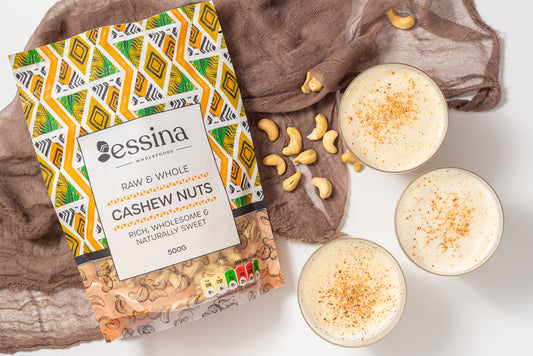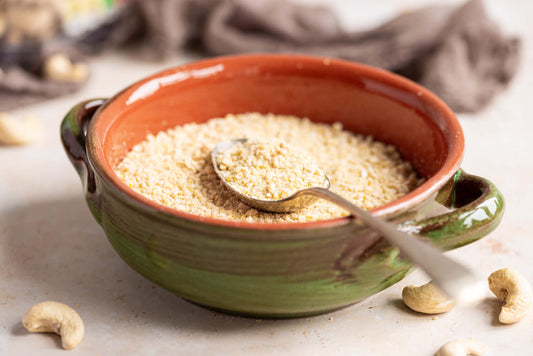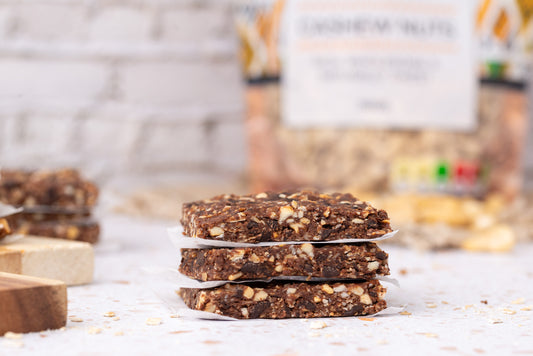The Origin of Cashew Nuts: Where Do They Come From?
Samale Nur
Cashews are the equivalent of culinary gold. They’re savoury, creamy, and perfect to snack on or throw into a meal. They’ve been used for centuries in different cuisines worldwide.
Nowadays, they can be found everywhere, from your favourite grocery store to fancy restaurants. And yet, for something so popular, there’s still a mystery surrounding their origin.
The Enigma Surrounding Cashews
The origin story of cashew nuts is shrouded in secrecy and myth. Some people claim that they come India or other parts of Asia; others argue that they hail from South America. This creates a mystery and confusion as to where does cashew nut come from.
The mystery surrounding these delectable treats only adds to their allure and makes them more desirable. So where do cashews really come from?
We can trace their journey across continents throughout history to present day. Join us as we explore the botanical background, cultural significance, global distribution, and more in our quest to unveil the truth about this beloved nut!
The Botanical Background
Cashew nut trees: description, habitat, and growth patterns
Let's talk about the cashew nut tree. This is a fascinating plant that deserves more attention. It is native to Brazil but now grows in many tropical regions around the world.
The tree itself is not very tall, reaching only about 30 feet in height, which makes it easier to harvest than other nut trees. However, it is still a challenge to get to those cashews as they are nestled in a fruit that looks like an apple.
The cashew tree has been adapted for survival in harsh conditions such as drought and poor soil quality. This makes cashew nut cultivation an ideal crop for farmers who don't have access to irrigation or fertile land.
The anatomy of a cashew fruit: what makes it unique
Now let's talk about the fruit of the cashew tree because this is where things get interesting. Unlike other fruits, the cashew "apple" (technically called a pseudo fruit) has no fleshy part. Instead, it's just a swollen stem that surrounds the actual nut.
What we refer to as 'cashews' are seeds enclosed in shells at the bottom of this swollen stem-like structure called an accessory fruit or false-fruit (not true fruits). The seeds within this structure are nuts since they have high oil content compared with most other plant-based foods.
How cashews are harvested and processed
Harvesting cashews isn't easy since each fruit only contains one nut, and they grow on small branches that can be difficult to reach. The process usually involves shaking the branches until the fruits fall off onto tarps below.
Once harvested, there are several steps involved in processing raw cashews into ones you can buy from stores or online retailers. This includes removing shells from nuts through roasting or steaming them to soften the shell and facilitate its removal.
After the nut is removed from its shell, they are packed ready for export to consuming countries. Cashews are at this stage often labelled as ‘raw’ since they’re free from additives, but they are safe to eat without further processing or roasting.
Personally, I find the process of harvesting and processing cashews fascinating since it shows how much work goes into making this delicious snack. However, I also have concerns about cashew nuts supply chains which mask cashew nuts country of origin and create a lack of transparency regarding where did cashews originate from or where are cashews produced for end consumers. The supply chains are usually shrouded with a lot of secrecy and controlled by large trade houses involving many middlemen in the steps from tree to table; in some cases more than a dozen. It's important to support brands that use ethical sourcing practices to ensure that farmers are being paid fairly for their hard work.
The Cultural Significance
Cashews in Ancient Civilizations: From Mayans to Indians
Cashew nuts have been a part of human civilization for thousands of years, and their cultural significance cannot be overstated. The ancient Mayan civilization in Central America believed that cashew nuts had mystical powers, and there the indigenous communities used cashew bark to make teas for asthma, colds, and congestion. Cashew bark tea was used for thrush and severe diarrhoea. Old cashew leaves were applied to burns and a tea made of leaves was used for sore throats. In fact, the cashew tree was considered a virtual pharmacy; its bark, juice, and nut oil were said to cure warts, corns, and calluses as well. In India, cashew nuts were considered a luxury food item and were often used in traditional Ayurvedic medicine to treat various ailments.
Cashews in Modern Times: Culinary Uses and Health Benefits
In modern times, cashew nuts have become a staple ingredient in many cuisines around the world. They are a popular snack food, but also add flavour and texture to dishes like stir-fries, curries, and salads. Additionally, they are often used as the base for vegan cheeses and creams.
But beyond their culinary uses, cashews also offer numerous health benefits. They are high in healthy fats, protein, vitamins E and K, and minerals like copper and magnesium.
Why Cashews Are So Expensive
Despite their popularity and abundance today, cashews remain one of the most expensive nuts on the market. There are several reasons for this. First, the process of harvesting and processing cashews is labour-intensive and dangerous - the outer shell contains a toxic resin that can cause skin irritation or even burn if not handled properly.
Second, historically, the bulk of the world's cashew supply has been sourced from two nations - India and Vietnam. Note I use the word “sourced” as opposed where does cashew nuts grow. Mainly because these two countries have over years become power houses when it comes to cashew processing. Thereby importing a lot of nuts in shell and undertaking the process of deshelling and packing. This limited geographic concentration means that any disruptions or shortages in these regions can cause dramatic fluctuations in cashew prices, reinforcing their status as a premium commodity.
The Global Distribution
Where do most cashews come from today? (Hint: it's not where they originated) In today's interconnected world, the cashew's journey from tree to table is a truly global endeavour, crisscrossing continents before landing in our kitchens. This global distribution reflects a nuanced map of cultivation, processing, and consumption - a vivid illustration of the complexities of modern food supply chains.
At the helm of cultivation, Africa stands as the largest grower of cashews, with vast farming lands stretching from Côte d'Ivoire to Tanzania, echoing the continent's profound agricultural potential. This domination in cultivation, however, does not directly translate to leading the processing or exporting side of the equation. Here, the spotlight shifts to Vietnam (Yes, you read that right – Vietnam!), a country that has remarkably mastered the art of cashew processing. Despite not being the largest grower, Vietnam has leveraged innovative processing techniques, stringent quality standards, and robust export capabilities to become the world's top cashew exporter. In recent years, Vietnam has been producing about 1 million tons of cashews per year and accounts for over 50% of global shelled cashew exports, which have propelled Vietnam to be the leading cashew exporter, ultimately underlining its significance of market supremacy. This also makes the country the world’s largest importer of in shell cashew nuts.
The final chapter of this global journey is penned in the kitchens of Europe and North America, the regions consuming the lion's share of the world's cashew supply. They relish cashews in a myriad of forms, from creamy sauces to savoury snacks, underscoring the universal culinary appeal and health benefits of this versatile nut.
It's important to recognize the layers of this global distribution - the sheer distance cashews travel and the diverse hands they pass through before reaching us. As consumers, it's not just the taste or health benefits of cashews that matter, but the practices behind their production. By supporting sustainably sourced and ethically processed cashews, we have the power to contribute to a fairer, more balanced global food system.
The Mystery Unveiled
Tracing Back the Origins of Cashew Nuts: A Journey to Brazil and Beyond
The origin story of cashew nuts is shrouded in mystery, but one thing we know for sure is that they didn't originate from where they are commonly grown today. The origin of cashews tree is native to Brazil, where it was first discovered in the 16th century.
From there, it slowly spread throughout the world. But even before, cashews were an important part of Brazilian culture. The indigenous people used them for food, medicine, and as a source of dye. To this day, Brazil remains one of the key producers of cashews in the world.
Exploring Different Theories on How They Spread Across Continents
There are several theories on how cashews came to be so widely distributed around the world. Some believe that it was through trade routes established by Arab merchants who traded with India and East Africa. Others think that Portuguese traders brought them to India in exchange for spices.
But regardless of how they got there, what's important is that cashews have become a global commodity with significant economic and cultural impact. They are used in cuisine all over the world and have been linked to numerous health benefits.
While we may never know for certain how exactly cashews spread across continents, what we do know is that their journey has been long and fascinating. From their humble beginnings in Brazil to becoming a staple ingredient in many cuisines around the world - there's no denying that these little nuts have come a long way!
Conclusion
Recap of Key Points Covered in the Article
Throughout this article, we've explored the fascinating history and origins of cashew nuts. Starting from their botanical background, we learned about cashew trees' unique anatomy and how they are harvested and processed.
We then delved into the cultural significance of cashews, from their use in ancient civilizations to their modern-day culinary and health benefits. We also looked at the global distribution of cashews today, tracing their journey from Brazil to Africa, Asia, and beyond.
We unveiled the mystery behind where cashews come from. Despite many theories, evidence suggests they originated in Brazil before spreading across continents.
Final Thoughts on The Fascinating Origin Of Cashew Nuts
It's amazing to think that such a small nut has such an intriguing history. From its elusive origins to its widespread global presence today, cashews have been a valuable commodity for centuries.
It is unfortunate that despite being so popular worldwide, most people know little about where they come from or how they are harvested. As we continue to enjoy cashews in our daily diets or use them as ingredients in various dishes around the world let's take a moment to appreciate their journey.
It is remarkable that something so seemingly insignificant can have such an extraordinary backstory. Learning about the origin of cashew nuts reminds us that everything we consume has a story behind it—a story worth exploring as it sheds light on our interconnectedness with other cultures and places around the world.







